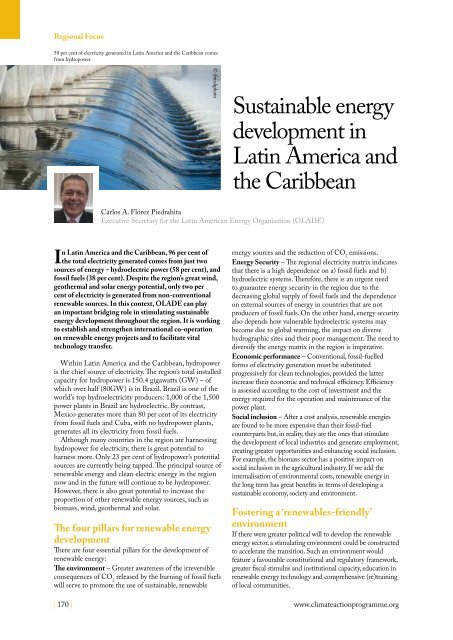Climate Action 2010-2011
Create successful ePaper yourself
Turn your PDF publications into a flip-book with our unique Google optimized e-Paper software.
Regional Focus<br />
58 per cent of electricity generated in Latin America and the Caribbean comes<br />
from hydropower.<br />
© iStockphoto<br />
Sustainable energy<br />
development in<br />
Latin America and<br />
the Caribbean<br />
Carlos A. Flórez Piedrahita<br />
Executive Secretary for the Latin American Energy Organisation (OLADE)<br />
In Latin America and the Caribbean, 96 per cent of<br />
the total electricity generated comes from just two<br />
sources of energy – hydroelectric power (58 per cent), and<br />
fossil fuels (38 per cent). Despite the region’s great wind,<br />
geothermal and solar energy potential, only two per<br />
cent of electricity is generated from non-conventional<br />
renewable sources. In this context, OLADE can play<br />
an important bridging role in stimulating sustainable<br />
energy development throughout the region. It is working<br />
to establish and strengthen international co-operation<br />
on renewable energy projects and to facilitate vital<br />
technology transfer.<br />
Within Latin America and the Caribbean, hydropower<br />
is the chief source of electricity. The region’s total installed<br />
capacity for hydropower is 150.4 gigawatts (GW) – of<br />
which over half (80GW) is in Brazil. Brazil is one of the<br />
world’s top hydroelectricity producers: 1,000 of the 1,500<br />
power plants in Brazil are hydroelectric. By contrast,<br />
Mexico generates more than 80 per cent of its electricity<br />
from fossil fuels and Cuba, with no hydropower plants,<br />
generates all its electricity from fossil fuels.<br />
Although many countries in the region are harnessing<br />
hydropower for electricity, there is great potential to<br />
harness more. Only 23 per cent of hydropower’s potential<br />
sources are currently being tapped. The principal source of<br />
renewable energy and clean electric energy in the region<br />
now and in the future will continue to be hydropower.<br />
However, there is also great potential to increase the<br />
proportion of other renewable energy sources, such as<br />
biomass, wind, geothermal and solar.<br />
The four pillars for renewable energy<br />
development<br />
There are four essential pillars for the development of<br />
renewable energy:<br />
The environment – Greater awareness of the irreversible<br />
consequences of CO 2<br />
released by the burning of fossil fuels<br />
will serve to promote the use of sustainable, renewable<br />
| 170 |<br />
energy sources and the reduction of CO 2<br />
emissions.<br />
Energy Security – The regional electricity matrix indicates<br />
that there is a high dependence on a) fossil fuels and b)<br />
hydroelectric systems. Therefore, there is an urgent need<br />
to guarantee energy security in the region due to the<br />
decreasing global supply of fossil fuels and the dependence<br />
on external sources of energy in countries that are not<br />
producers of fossil fuels. On the other hand, energy security<br />
also depends how vulnerable hydroelectric systems may<br />
become due to global warming, the impact on diverse<br />
hydrographic sites and their poor management. The need to<br />
diversify the energy matrix in the region is imperative.<br />
Economic performance – Conventional, fossil-fuelled<br />
forms of electricity generation must be substituted<br />
progressively for clean technologies, provided the latter<br />
increase their economic and technical efficiency. Efficiency<br />
is assessed according to the cost of investment and the<br />
energy required for the operation and maintenance of the<br />
power plant.<br />
Social inclusion – After a cost analysis, renewable energies<br />
are found to be more expensive than their fossil-fuel<br />
counterparts but, in reality, they are the ones that stimulate<br />
the development of local industries and generate employment,<br />
creating greater opportunities and enhancing social inclusion.<br />
For example, the biomass sector has a positive impact on<br />
social inclusion in the agricultural industry. If we add the<br />
internalisation of environmental costs, renewable energy in<br />
the long term has great benefits in terms of developing a<br />
sustainable economy, society and environment.<br />
Fostering a ‘renewables-friendly’<br />
environment<br />
If there were greater political will to develop the renewable<br />
energy sector, a stimulating environment could be constructed<br />
to accelerate the transition. Such an environment would<br />
feature a favourable constitutional and regulatory framework,<br />
greater fiscal stimulus and institutional capacity, education in<br />
renewable energy technology and comprehensive (re)training<br />
of local communities.<br />
www.climateactionprogramme.org












